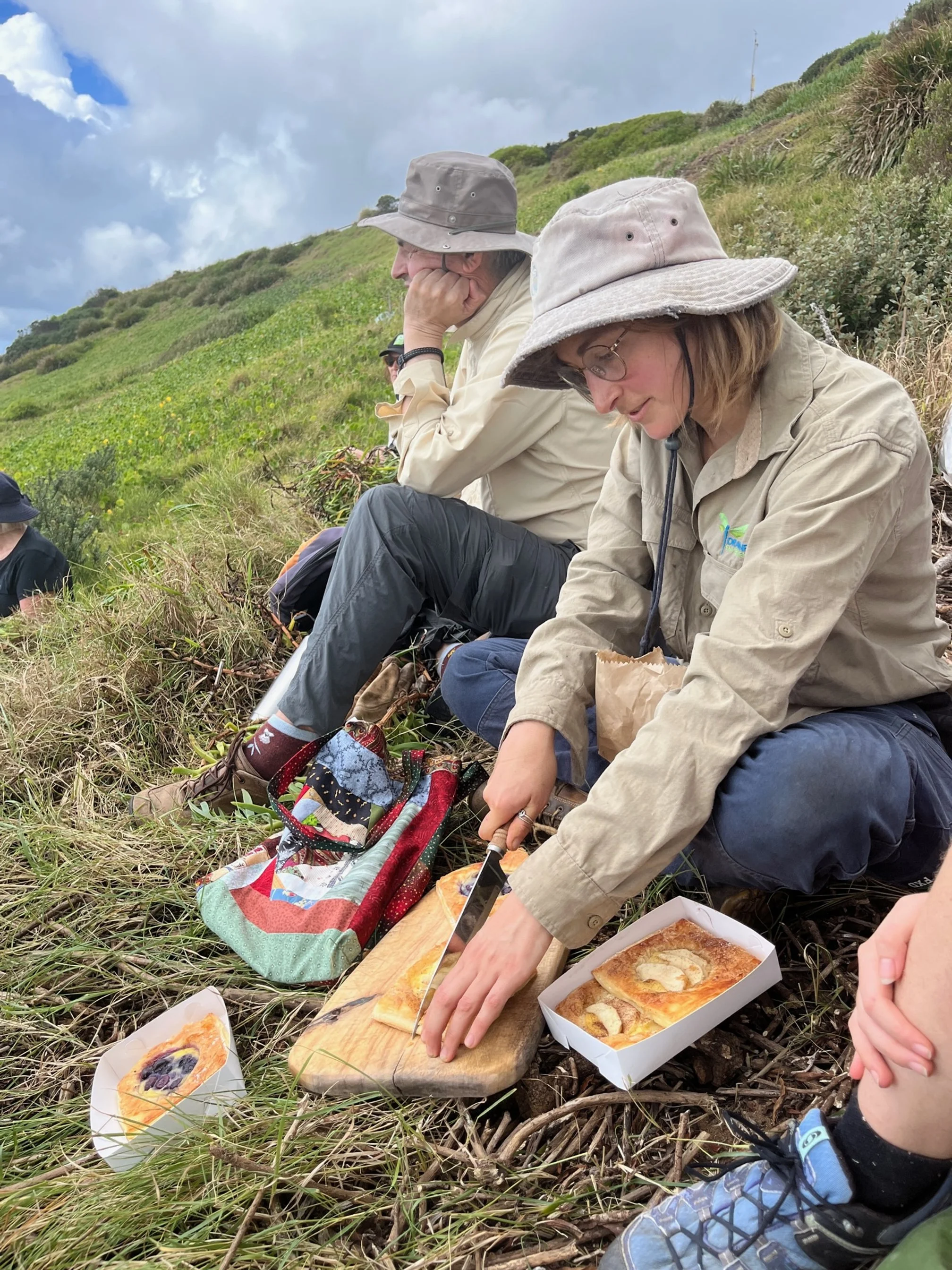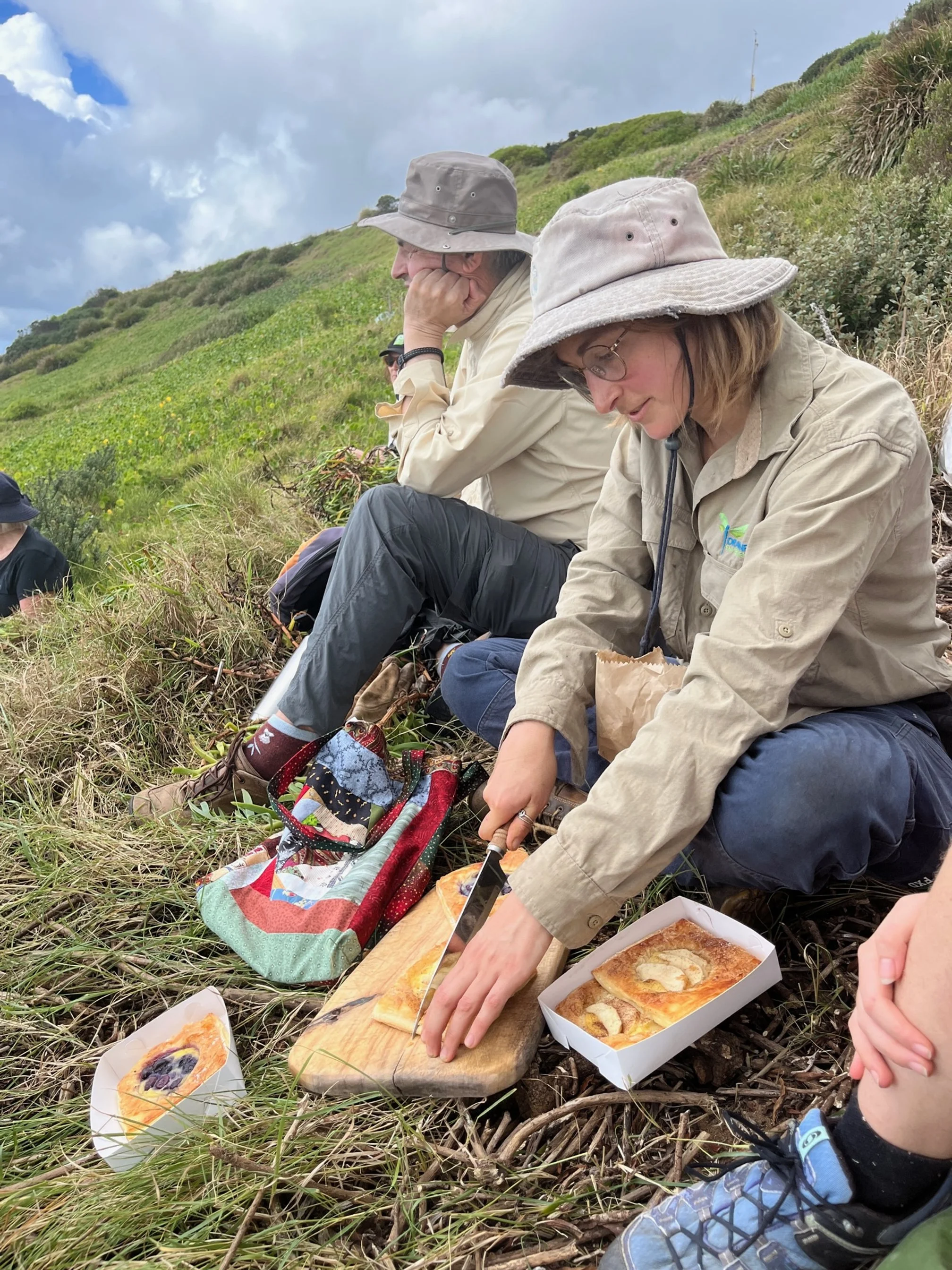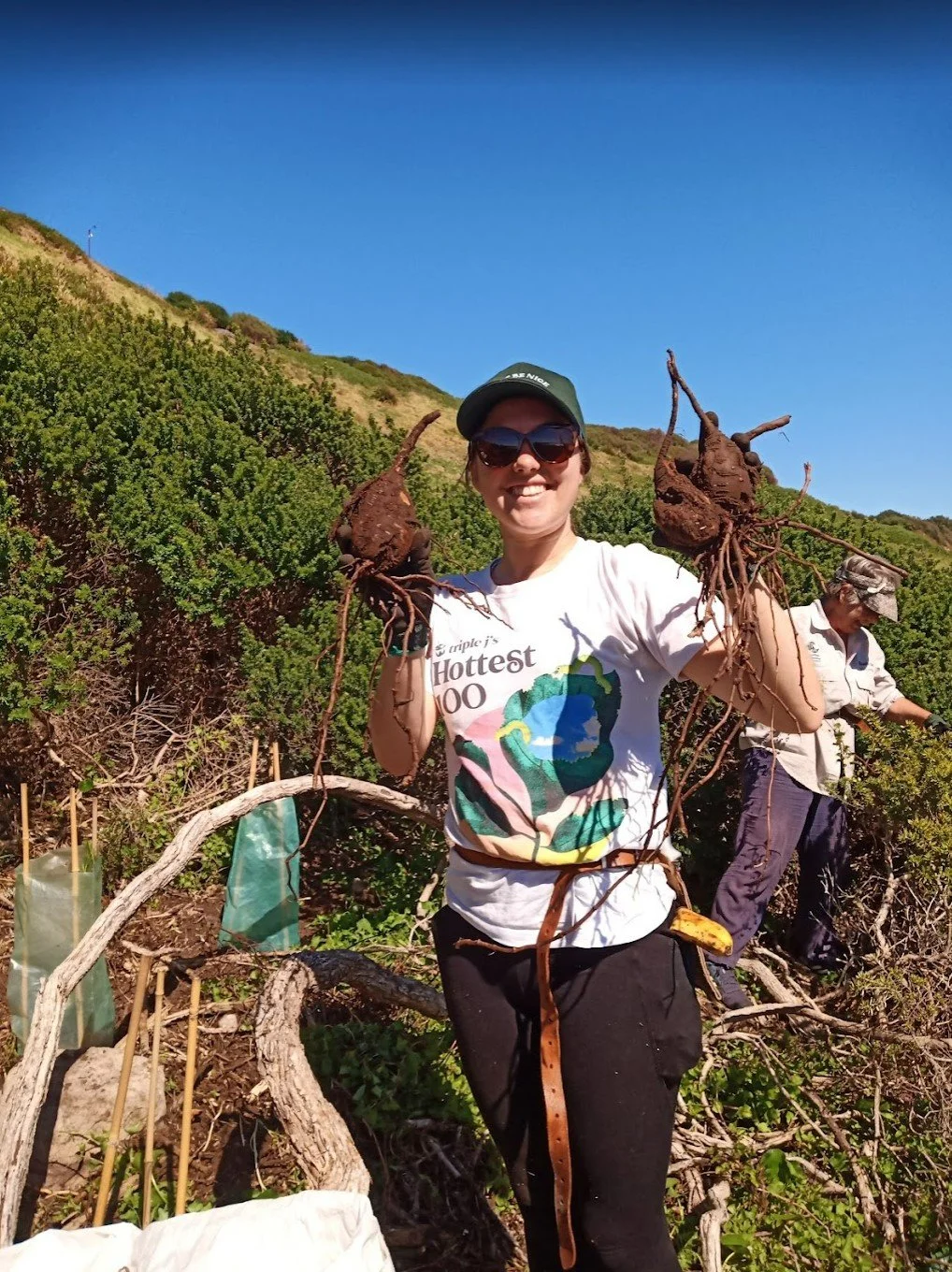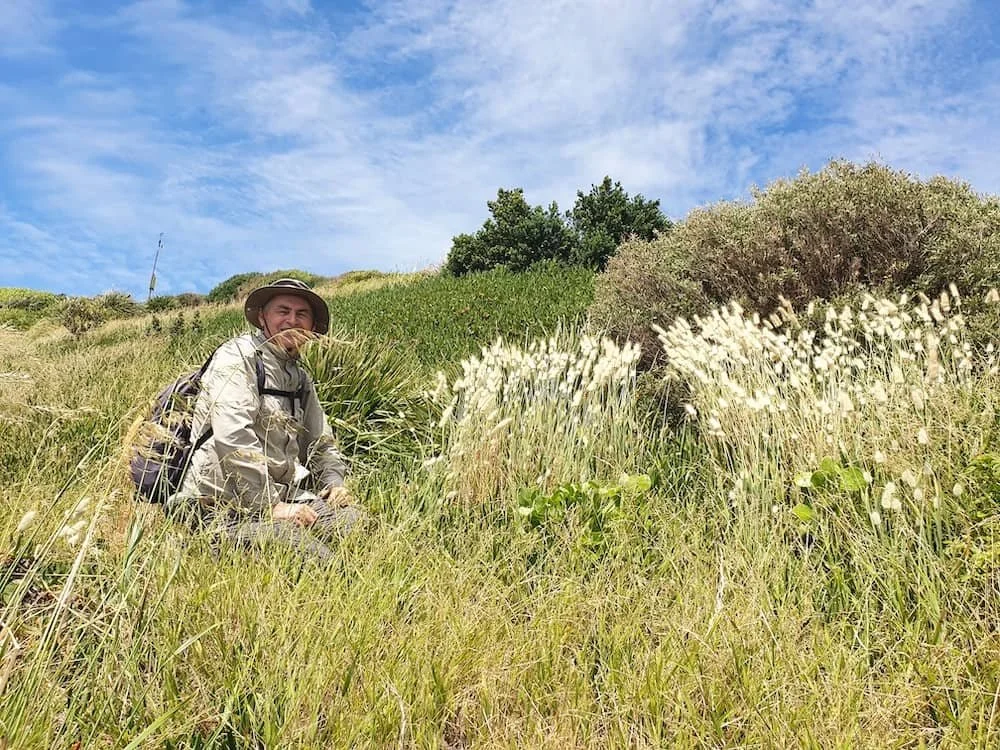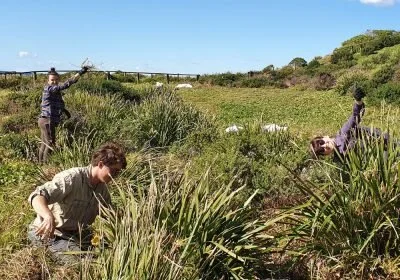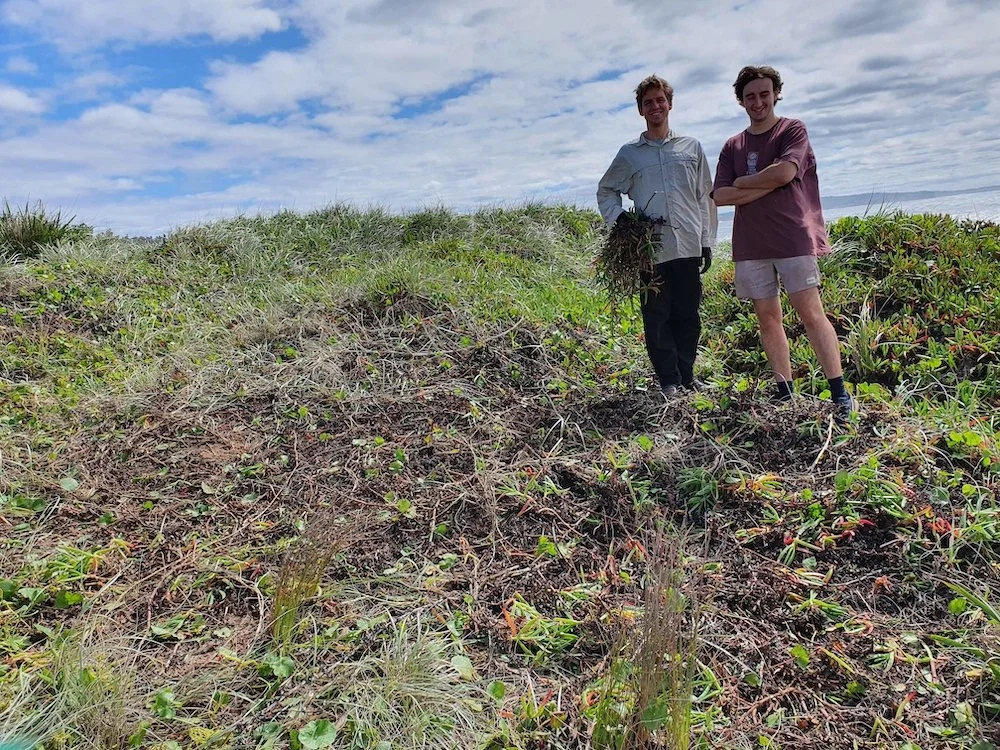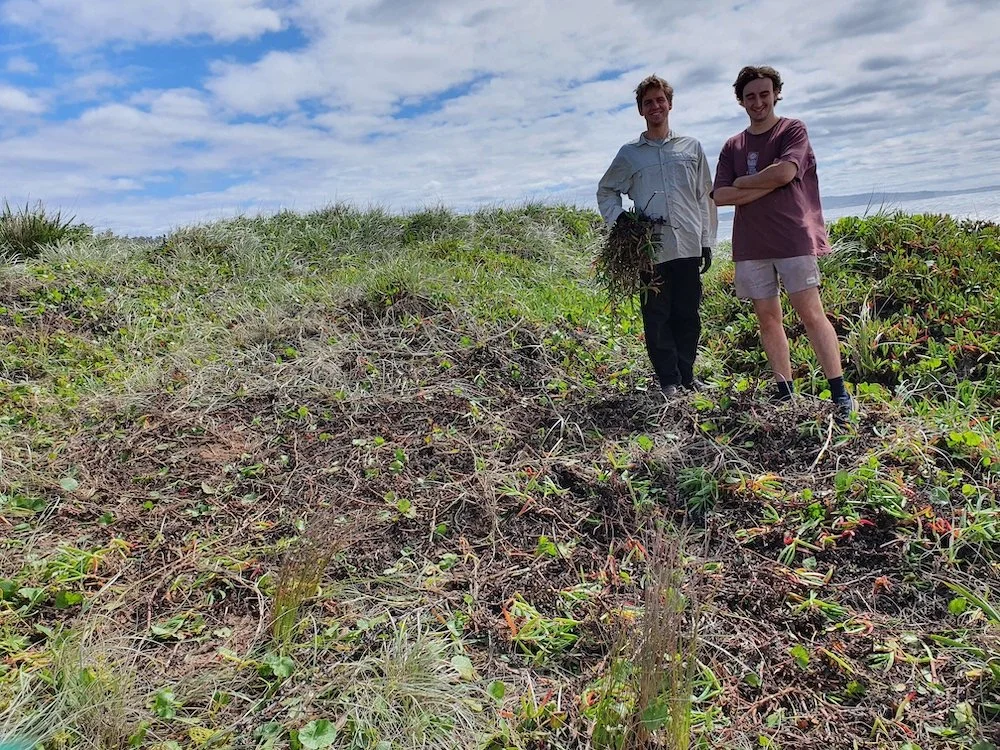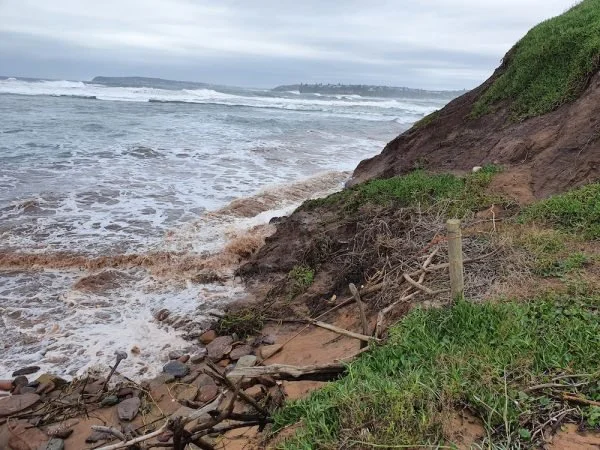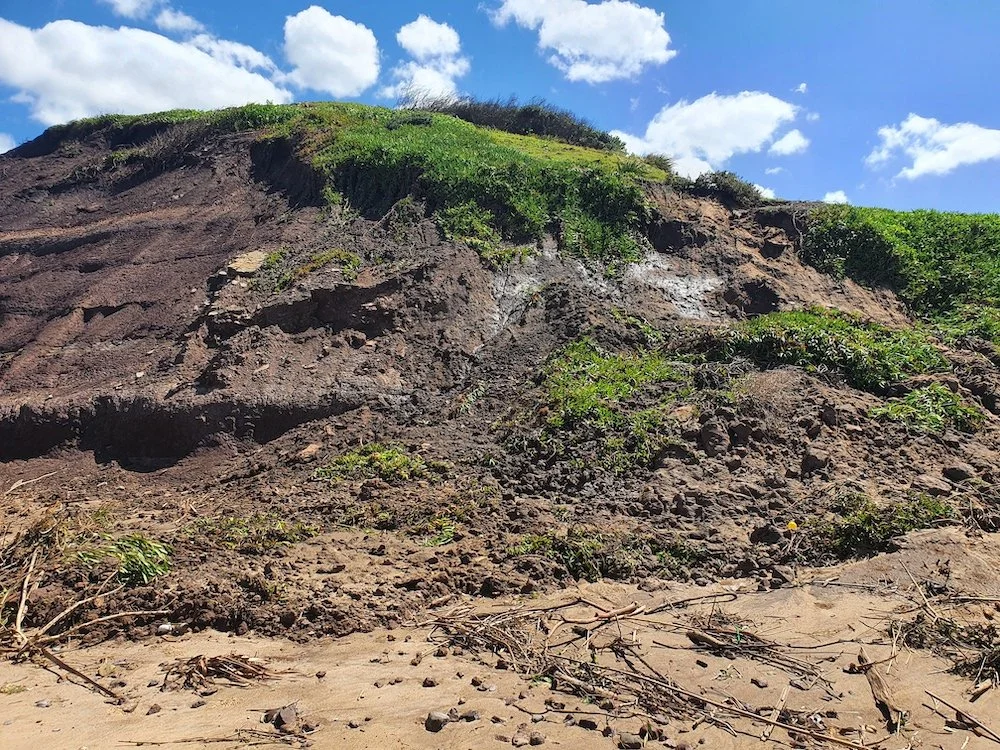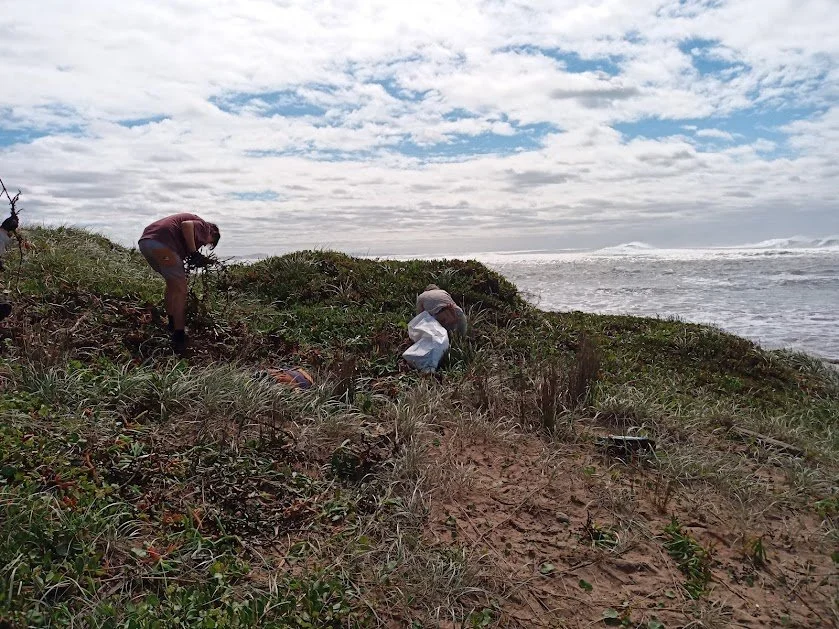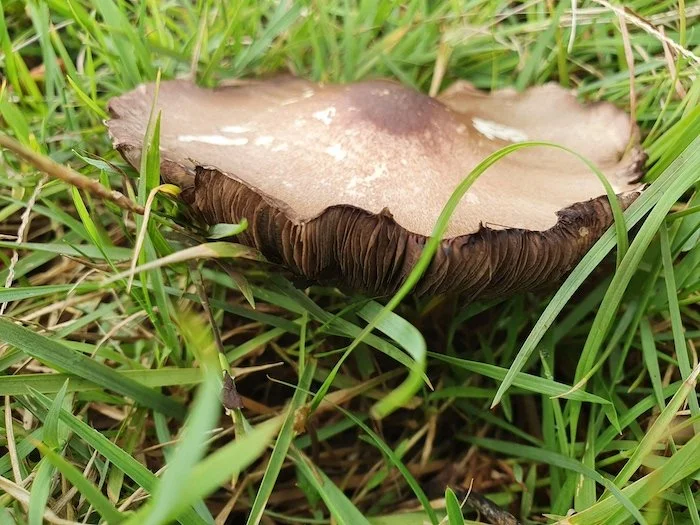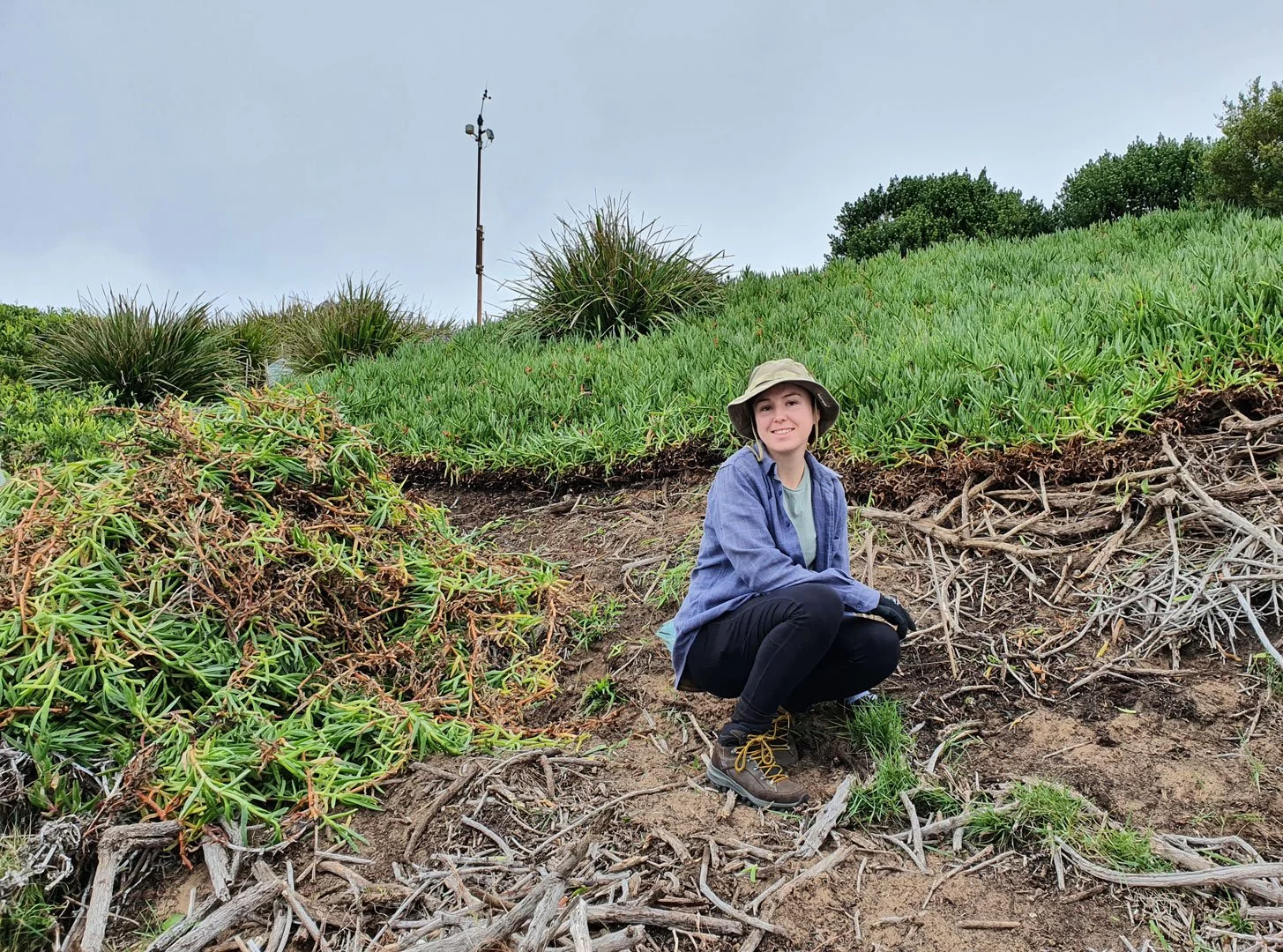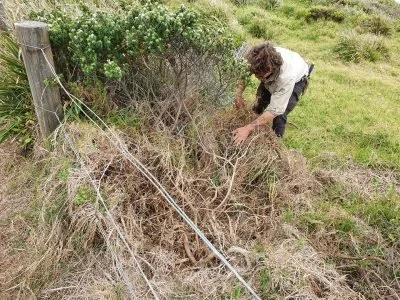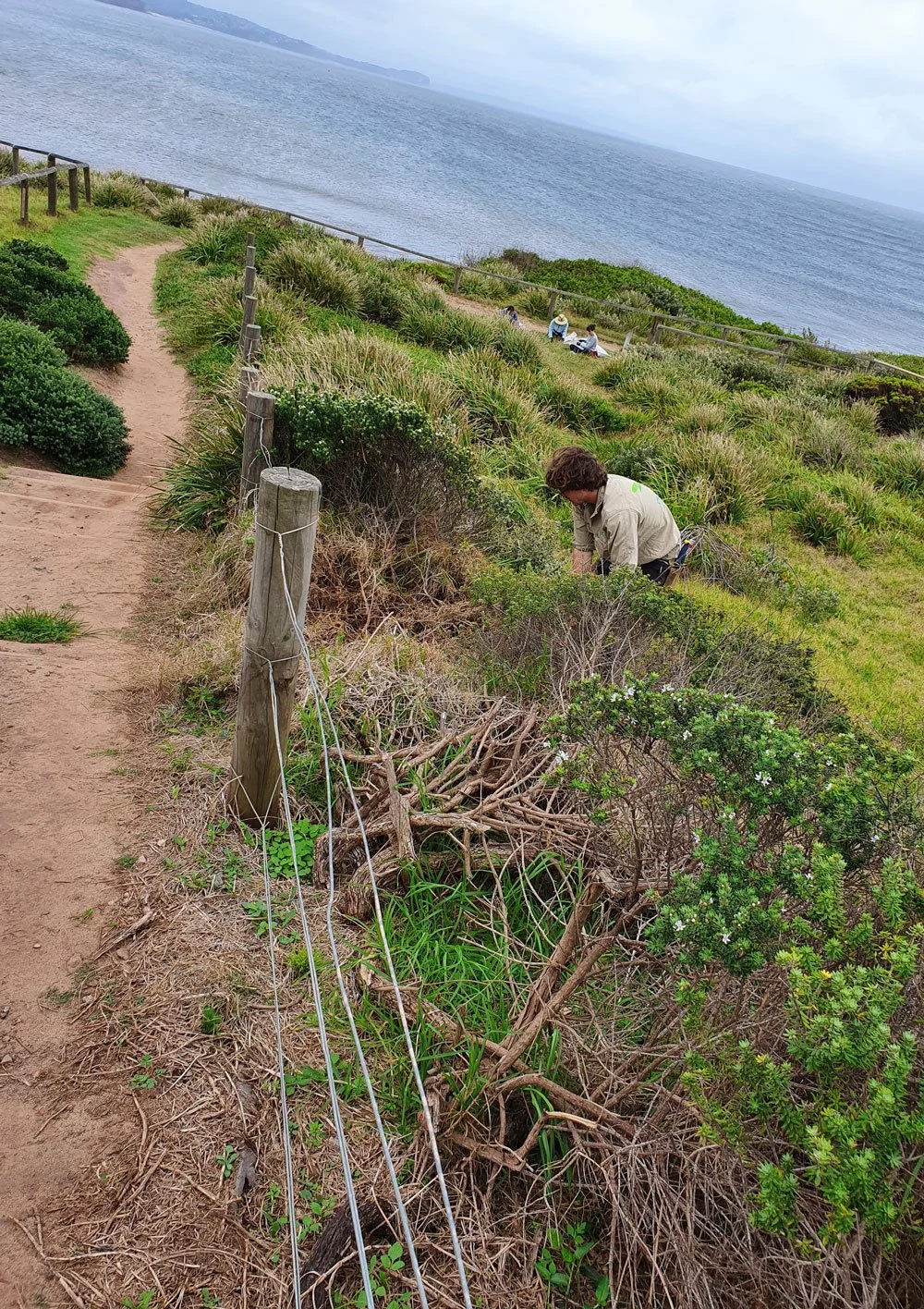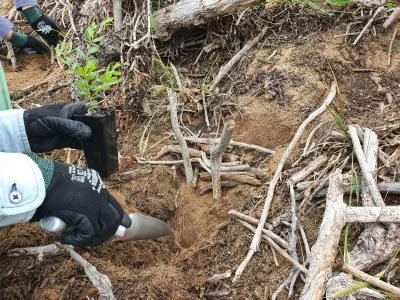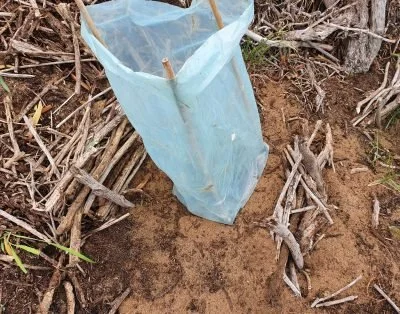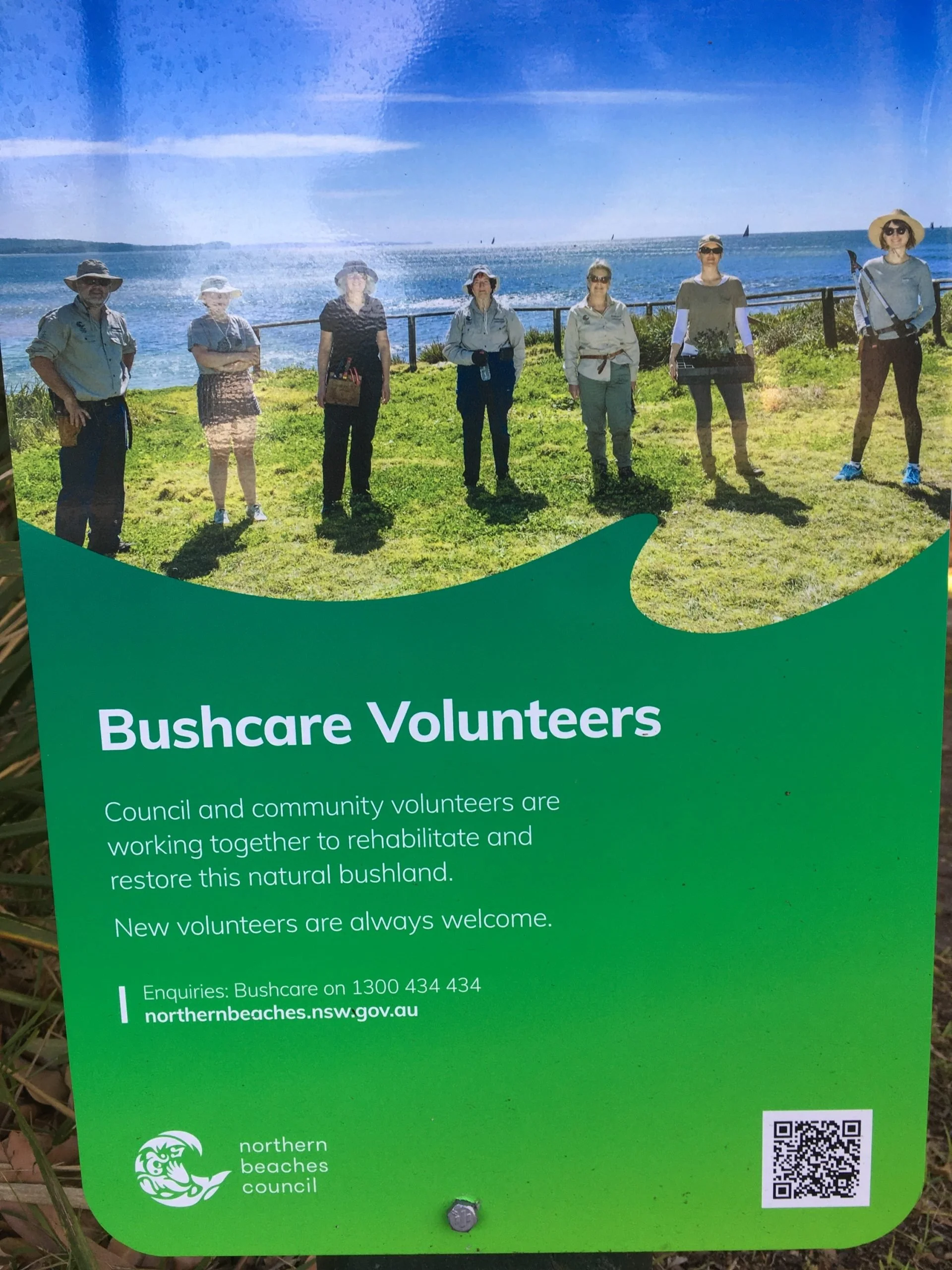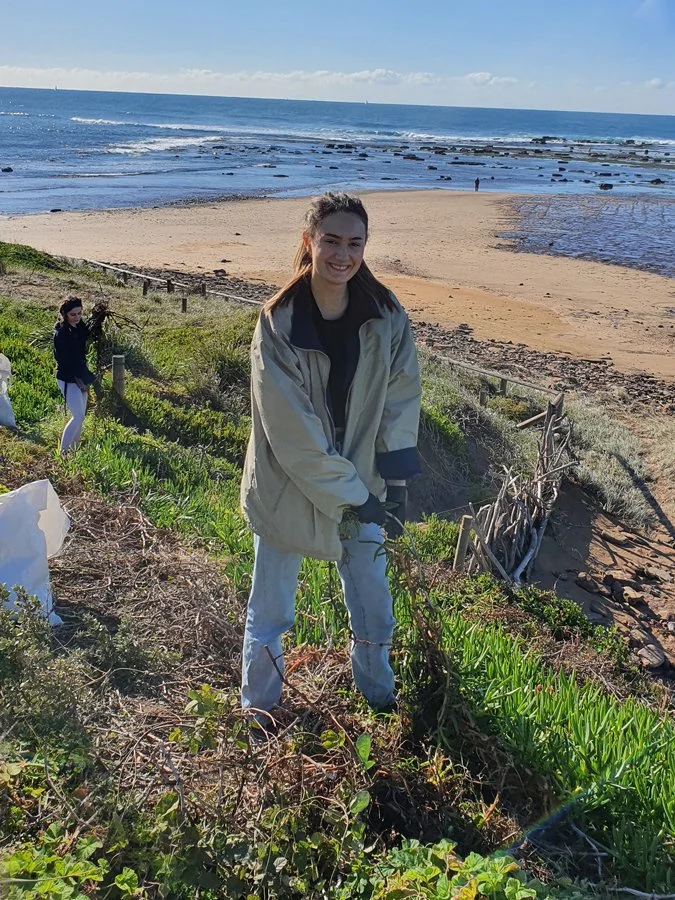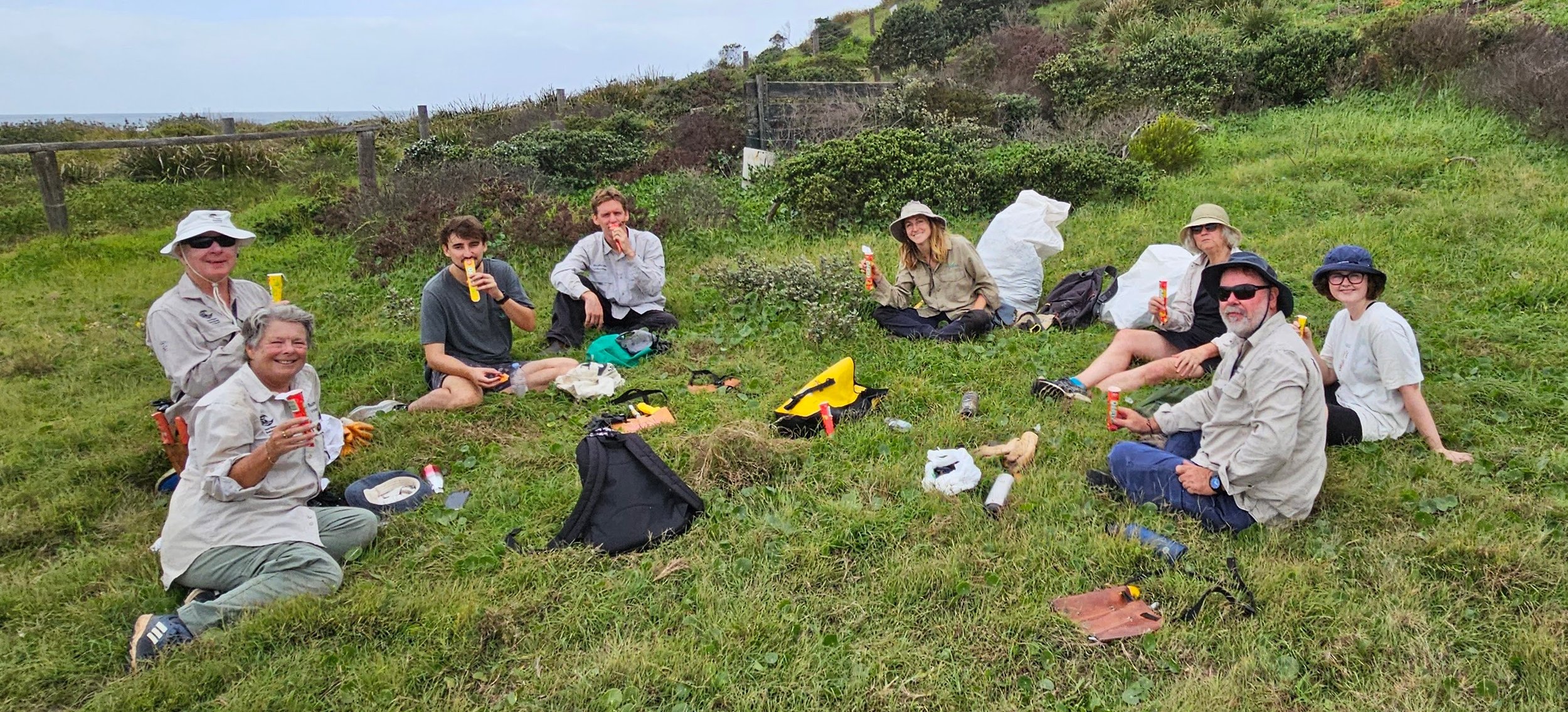
Blog
Reefcare Day Report: Weeding and Planting
What a beautiful sunny and warm day is was to work at Long Reef – and watch whales at morning tea time – and this is just into winter by 2 days …
Morning tea by the beach
What a beautiful sunny and warm day is was to work at Long Reef – and watch whales at morning tea time – and this is just into winter by 2 days – who would know! Lawson from Dragonfly Environmental was our supervisor for the day, this was his second time on our site, so it was great as he already knew a number of the Reefcare people and what our current priorities are on site.
Julie worked high up on the western slope removing more bitou, but she also planted 7 tube stock where removal of Bitou has previously taken place – there has not been much rain, so Julie will go back to site next weekend, and the one after – to water the new plantings as she reports the soil is very dry – which means she will also be watering the previous months plantings, which is great, as we have not had much rain the past month.
Merrilyn, Brad and Gen had about 17 tube stock plants which they managed to get in before morning tea – which is great work as terraces need to be made due to the steep slope, so it’s quite a slow job to get plants in the ground. They also took about 12 litres of water so these and previous plantings all got a good drink. This was done before morning tea and after morning tea, they worked westward with the removal of bitou. The cut bitou was put into the sand gully which will reduce erosion and eventually break down giving some substance to the exposed sandy soil in this gully area.
Before morning tea, Lisa, Ivana and Claire worked on the Turkey Rhubarb on the flat behind the sign – the number of bulbs that we are still finding after 3 years working in this area is ridiculous. John and Alex worked in what we are now calling ‘The Nest’ as it is an area surrounding by Westringa, also on Turkey Rhubarb bulbs – and they got even more than the girls. Alex found a one cent coin dated 1966 – we are wondering if it has doubled in value. Meanwhile Lawson roamed the site for Bitou.
Maria turned up at morning tea time – just in time to be spoilt, as Claire had brought lamingtons and John brought Anzac biscuits to share with the group – good timing Maria!
After morning tea, John and Claire worked on removing Buffalo grass and Kikuyu off some of the Lomandra along the northern edge of the site, Maria and Ivana continued on Turkey Rhubarb on the flat, whilst Lisa and Alex removed more of the non-native pigs face on lower western side of the site – just below where Brad, Merrilyn and Gen were working. Most of this was removed two months ago, but we didn’t quite finish, getting rained out at 11:30am. There is still a little left which Alex said he will finish off next month.
Removing invasive grasses
John removes buffalo grass and bunny tails.
Reefcare Day Report: Digging for Turkey Rhubarb bulbs
Alex likes to tackle Turkey Rhubarb and there was a lovely amount of that waiting for him in the middle of the Westringa circle – his excitement which was so absolutely palpable, we all could do but nothing but follow him!
We were a bit slim on the ground today with just Des, Merrilyn, Gen, Naomi (our Dragonfly supervisor for the day) and myself (Lisa) – and then just when we were leaving the car park, Alex and Josh turned up. YEAH!, – that made 7 of us. Maria and Julie turned up later so it quite a decent crew at the end of the day.
Because Alex likes to tackle Turkey Rhubarb there was a lovely amount of that waiting for him in the middle of the Westringa circle – his excitement which was so absolutely palpable, we all could do but nothing but follow him! So that is where Naomi, myself, Josh and Alex spent the whole working bee – and we only got about 50% done in this site despite all this time on the damn weed – so Alex will be really excited that he once again has a job and a half on his favourite work for next month. Is Alex mad or insane – the jury is out, but thank goodness for Alex. Of course, there was the competition of the largest Turkey Rhubarb found and we think it was a draw with Naomi’s big carrot and Josh’s twin bulbs.
Merrilyn and Gen had 6 plants for Julie’s area (she was not able to arrive until after morning tea), and they report that the previous plantings are all do well, and there is a high success rate. Merrilyn and Gen also planted before and after morning tea the plants that Brad ha requested. Planting takes a long time due to the step slopes, terraces need to be made and tracks for the plant to obtain water from above, and then need to be mulched – we find so often when these parameters are taken into consideration, that the survival rate of our plants are really high.
Reefcare Day Report: Danish Pastries for tea while birds soar overhead
The working day was often interrupted by watching the amazing display of the birds of prey circling around the southern of the ridge …
Great teamwork clearing the non-native pigs face.
We had a great start to our cooler sunny day with all our participants arriving well before 9:00am so we could sign on, organise the equipment required, who was going where and the respective tasks for the working areas in which work was to be undertaken. The great team of 11 took all the tools which were all used! 8 tool belts, 3 loppers, 3 mattocks and a small Peter lever, several weed bags (less used this month!) along with the 8 x 2 litre bottles of water and the 8 plants for the North-West area and 25 plants on the far western area where we are working to remove bitou and the non-native pigs face. It was a lot of equipment for the team, but it was all required. The group accomplished a huge amount as the photos from the day will show.
Alex and Tayla worked on Turkey Rhubarb in a defined area on the top southern slope (the clump that Brad Law found about 4 months ago) and they found some really good-sized bulbs – Lisa had no idea that this area was such a problem for this weed – so will ensure we follow up next month in this area. Alex and Tayla worked in this area after morning tea as well – determined to get all that they could. Brad, Merrilyn and Gen planted eight tube stock plants of six different species in the top western area where Julie usually works removing Bitou (Julie was away in Orange this month). Once completed they then moved down the slope to where most of us were working, to work on bitou removal, just above the group removing the non-native pigs face. Gen did some planting and whilst doing so, came across a beautiful small light pink and green spider, it was so pretty – we tried to photograph it, but it wouldn’t keep still for 1 millionth of a second.
Kristie treads lightly on the step slopes as she plants native pigs-face seedlings
Maria arrived about 10 and with Gen after helping with the planting (being a slope terraces needed to be made which means planting takes some time), they worked with Brad and Merrilyn with Bitou removal.
The working day was often interrupted by watching the amazing display of the birds of prey circling around the southern of the ridge from where we were working, they were so prevalent that morning – it was just wonderful watching them circle so close to us – sea eagle, osprey, 4 nankeen kestrels, ravens – a flock of cormorants and we are sure there was another species which we couldn’t identify – it was a fabulous day for bird spotting – that’s for sure!
We had a fabulous morning tea on the slopes overlooking the ocean, enjoying the Danish pastries that Kathy and brought for us – thank you Kathy!
Kathy brought Danish pastries to enjoy by the sea – Thank you Kathy!
Danish pastries, good company and a beautiful ocean view
John, Kathy (our new Supervisor from Dragonfly), Ivana, Kristy and Lisa worked on various tasks from removing the non-native Pig’s face and planting on the slope just east of a sand gully – which unfortunately we cannot remove the last of the bitou due to bad potential of erosion with the sand gully. This is an area that unfortunately is often used by the public for running up and down these sand gaps causing erosion. What was really exciting was that as we moved down the slope we had a good cover of native couch underneath the pigs face – and what we think is bladey grass – Kathy will look into this identification to confirm.
Reefcare Day Report: A Warm Sunny Day of Weeding
Lisa gave another update on the meeting with Council who are looking to form a volunteer group ‘Friends of Long Reef’ …
Josh and Alex in "The Nest", tackling the Turkey Rhubarb.
t was a warm summer’s day as we headed down to our work area at Long Reef point, with John, Stella, Gen and Claire stopping at two locations just north off the track into our work area where there was a patch of non-native pigs face, one spot where it was growing over our natives and the track fence. Julie continued to work up the top on Bitou and she had two plants to get in the ground in her area which is steep and thus there is some time needed to create terraces when planting. Merrilyn weeded on the top slope whilst Brad weeded and planted the remaining five plants on the western side near the gully. Des scouted the site for asparagus fern.
The rest of us, Lawson, Maddie, Elaine and Lisa started work on the turkey rhubarb (Acetosa sagittate) on the flat ground. It wasn’t long until John, Stella, Gen and Claire joined us in the hunt for turkey rhubarb bulbs. Then Alex and Josh turned up and they elected to go to the second area of our turkey rhubarb infestation in the middle of a patch of the Westringia fruticosa – which is not an easy area to work in with the branches and roots. With so many on the first site working on the Acetosa sagittate I went up the slope (pulling out Bitou seedlings on the way) to assist Merrilyn with weeding and a little bit of the non-native pigs face where it was growing over our plantings. The long heavy stems of this creeper are not good for these small plants.
Maria arrived just before morning tea so there was quite a group of us there chatting as can be seen in the morning tea photo of the group. Lisa gave another update on the meeting with Council who are looking to form a volunteer group ‘Friends of Long Reef’, as a couple of our members are very interested. Lisa then gave a list of different areas and jobs that could be undertaken on site, thinking that people could be bored with the hunt for Acetosa sagittate bulbs – but no… most wanted to go on the hunt for more bulbs!
Our traditional morning tea.
Elaine went up the slope to continue weeding where Merrilyn and I had been before morning tea, whilst I went across the gully to weed, as I knew it needed help. Brad and Merrilyn worked on cutting back Bitou and as time went by, John and Maddie joined us, and worked on bitou west of the gully – Lawson above and west of the gully, and then Gen and Stella joined Brad and Merrilyn. Des appeared cutting back bitou from the northern dunes that were growing over our Themeda.
On the way back, Lisa walked with Merrilyn, Brad and Lawson – and found a huge asparagus fern. Being tired and out of water, Brad and Lawson just cut off any branches with berries – a job for Des to tackle next time! Lisa sat under a Leptospermum laevigatum, watching the boys, as Lisa was not feeling the best, as Lisa had already depleted her supply Merrilyn kindly gave Lisa the rest of her water – thanks Merrilyn! Low and behold, not long after that Merrilyn found a snail shell on one of the grass tracks just below the whale sculpture – Brad now has this to determine if this is a trump snail or a Maroubra snail – we are waiting with baited breathe for the verdict.
The group arrived back in the car park very much in drips and drabs (head count was done!) with most wanting to head off as fast as possible for a very well-deserved swim instead of joining Lisa, Des and Maria for coffee.
Reefcare Day Report: Todays Challenge, Who can dig up the biggest Turkey Rhubarb Bulb …
The tube stock planted there previously over the past few months are alive and a couple are doing really well …
Great haul of turkey rhubarb tubers, Tayla!
Luckily the day was not too hot compared to the week before and there was a slight breeze onto our working area of the northern side of our site.
We were hoping with the lack of seasonal weeds to start tackling the kikuyu and buffalo grass on the northern dunes and just east of the main track, but that did not happen!
Unfortunately, we had to spend our time on more follow up of the two Turkey rhubarb (Acetosa sagittate- it is a native to Southern Africa) areas. Julie, Claire, Des and John spent their time on the area just north of the Bush regeneration sign on the left – this is an area we have now been working on for about 3 years – it is getting less, but it requires constant follow up. The tube stock planted there previously over the past few months are alive and a couple are doing really well – here’s hoping we get some good shrubs going to compensate for the loss during all the wet weather of a considerable proportion of Westringa dying. The other area was of the one we found in November last year in the middle of a ring of Westringa (found due the dying mature plants), it has probably been there for some time un-noticed but Jarrah, Tayla and myself worked there until John joined us for awhile. Tayla and Des were a little late in joining us as down the bottom slope, as they spent some time with a little area just off the track to get rid of a small patch of non-native pigs face and an asparagus fern. Des after this interlude scouted the site for new bitou plants and asparagus fern which he found was more work than just scouting.
Turkey rhubarb hunting in the “nest”
At morning tea, Merrilyn and Brad arrived. John presenting us all with a Calypso ice block! I’d never seen one before, but it was really lovely and everyone enjoyed this generous gift and thought by John for the group. It was exceedingly well received.
Jarrah tackles the emerging turkey rhubarb seedlings.
Whilst enjoying our Calypso ice blocks I updated the group with regard to the inaugural meeting I attended on 2 February in the Fisherman’s room at Fisherman’s Beach, Long Reef, by Robynne from Northern Beaches Council to create a ‘Friends of Long Reef’ group – her previous experience being in creating the now well established ‘Friends of Cabbage Tree Bay’.
After morning tea, Jarrah, Tayla, John and I went back to the Turkey rhubarb in the middle of the Westringa, Julie and Claire worked in this area until finished and then worked on Dandelions on the flat. Brad, Merrily and Des went back to the gully to weed and plant the 6 tube stock that we had for this month.
Another beautiful day enjoying and protecting nature
Reefcare Day Report: Looking for Maroubra Snails …
Brad Law showed us a collection of what is probably the Maroubra Snail shells which he had found on site during the past week …
Lovely morning tea with great company and great environment
Meeting in the car park, Brad Law showed us a collection of what is probably the Maroubra Snail shells which he had found on site during the past week – this was to educate the group to the difference between the imported trump snail and the native endangered Maroubra Snail. Thus we were all to be on the alert for any snail found. Unfortunately, no one in the group found on this Saturday. The Museum has asked Brad to find one live Maroubra snail so that they can do DNA.
The group started the day with following up on Turkey Rhubarb on the two locations which were heavily infested with this hideous vine that sends out so many bulbs – even latterly along the root, it will be damn hard to completely get rid of it in these two places, but we shall preserver. There was also weeding around the Lomandra on the northern flat end – thistles, burr medic to name but a few with Jarrah, Lisa, Alex, Claire and John. Brad, Gen and Merrilyn planted 8 tube stock in and around the dying Westringa (where they will be sheltered over the coming summer) to get some different shrubs in for the birds and hopefully help increase the diversity of species on our site. We continue to find more and more fauna as the site improves from the previous mono culture of Bitou.
Unfortunately, Lisa found another and rather lengthy 3 stemmed, Star Burr (previous advise from Georgia Williams (NB Council) is that is from Western NSW – species unknown) quite some metres from the original find of this weed just of the track about 2 months ago. Next time Lisa will do a line search between the two finds and make sure there are no more.
Morning tea was fabulous this month as John brought a big pack of Anzac biscuits – along with a lovely red and white table cloth and divine moist banana bread. This was far better than my normal supermarket purchased muesli bar that I eat at morning tea – thank you John! Everyone was delighted and especially impressed with the little tablecloth. There was certainly some excitement with those Anzac biscuits as there not too many Anzac biscuits left, think most of us had 2.
After our indulgent morning tea, the group more or less dispersed heading west across the site and undertaking general weeding. However Jarrah found a horribly big crop of weed grass like bromus but smaller seed heads, and ‘bunny tails’ / ‘fluffy bums’/ so Alex, Jarrah, John and I went in to tackle these plants with seed heads before the seeds were released. Jarrah and Alex worked eastward, whilst John and I worked westward. Claire worked below this area on general weeding. Merrilyn, Gen and Brad worked in the gully area – where Gen found a small mammal skeleton in a small cliff face, she thinks it is either a baby rabbit or a rat and is going to try and identify it. Photos were taken, and she has taken the bones. Be rather thrilling if the bones can be identified. The kestrel was around most of the day, but whilst in the gully the team were very excited to see a Peregrine Falcon come in – so our site is definitely providing food for our native birds. All the effort is certainly worthwhile seeing this change with an increase in birds of prey.
Julie worked on the western slope with removal of small number of young Bitou seedlings along top fence and down slope. She checked Des’s plantings and remove weeds inside their wind covers. Julie then planted and watered 3 x Melaleuca hypericifolia (commonly known as Hillock Bush) well established tube stock in gaps in top slope – so hopefully, they will do well. Julie continued working on the large Bitou bushes by cut/ paint and scrape herbicide- along top slope at the interface with Coastal Tea-tree/ Wattle.
John, enjoying the weeding
Our supervisor Jarrah, from Dragonfly environmental, tackles the weeds
Reefcare Day Report: We find the rare Maroubra Woodland Snail
It looks like that Brad Law has found the endangered Maroubra Snail on our site. Meridolum maryae which is confined to a narrow band of habitat along NSW coast
Claire digs out a nice turkey rhubarb bulb.
Given the frightful discovery of what we have found last month, is an established (at 2 year plus given the size of blubs found according to Jarrah) patch of Turkey Rhubarb, in the dying Westringia – this was our target!
It was such hard work – getting into the ground below the established (live and dying, each was a huge and difficult obstacle for us getting into this area) Westringia, roots, branches everywhere – it was seriously hard work, being into this bush, the small breeze that day alluded us. It was seriously hard work and thank you all who didn’t give up.
Turkey Rhubarb has a deep and extensive root system with bulbs that can regenerate the plant if not completely removed.
But, to make it fun there was competition as to who could find the largest Turkey Rhubarb bulb. There is no doubt that Jarrah found the first of the biggest Turkey Rhubarb bulbs – over a hand size, deserved so much as he ploughed in and was more of a ferret than a human – this is meant as a compliment Jarrah! – I saw you go in for the kill, it was more than admirable for your tenaciousness [LC1] to get to the source.
Hence the competition was on. Who could find the biggest Turkey Rhubarb bulb?
There were quite a number of great finds of seriously big bulbs, but there was also finds of more than dozens and dozens of smaller bulbs – we think there was over 20kg of bulbs at the end of the day. (Thank goodness we have Jarrah could carry this seriously heavy bag to the carpark – I could barely lift the bag).
We were told that the Turkey Rhubarb bulb was edible, so Claire, one of our volunteers, was brave enough to cook (baked in the oven for an hour and a half) and tasted the Turkey Rhubarb. Claire can confirm that it tastes horrible and very bitter. “I won’t be recommending it or eating it again, I only managed a tiny taste”
So next working bee will be a follow up on Turkey Rhubarb the and then hopefully we can plant and get some shrubs in for the birds and then help increase the diversary of species on our site -as we continue to find more and more fauna as the site improves from the previous monoculture of Bitou.
Julie did a short day, but in this time she undertook eradication of small bitou seedlings – mx 6″ high. Julie checked bitou poisoned last time (all dead), and then did another 2 big bitou bushes on the west edge of good bush. Doing a mix of cut/ poison paint and scrape/ poison paint- due to the size of the stumps and the terrain.
I was brave enough to cook (baked in the oven for an hour and a half) and taste the Turkey Rhubarb, and I can confirm that it tastes horrible and very bitter. I won’t be recommending it or eating it again, i only managed a tiny taste. (see pics below).
Claire tries cooking up the turkey rhubarb bulbs for the evening meal.
Maroubra Woodland Snail.
There is an exciting addition to all for Reefcare Volunteers to be aware!
It looks like that Brad Law has found the endangered Maroubra Snail on our site. Meridolum maryae which is confined to a narrow band of habitat along NSW coast
For more information on this snail visit – Maroubra Woodland Snail – profile | NSW Environment, Energy and Science
Brad has been dealing with Dr Stephanie A. Clark – Director, Invertebrate Identification who advises……
In my paper of 2009, there were specimens from Long Reef ranging in age from 1946 to 1991, but I don’t remember if any of them looked relatively fresh. But if you can find a fresh one that would be great.
We do also have the invasive Trump Snail on site which is quite similar – so if you find a snail or a snail shell on Saturday, please refer to Brad to determine if it is possible the Maroubra Snail or the Asian Trump Snail. Attached is a photo I took on site of the Asian Trump Snail
Fauna of Long Reef
Common Name – Asian trampsnail
Family – Bradybaenidae
Genus – Bradybaena similaris
As the common name suggests, this small invasive land snail Bradybaena similaris, the Asian tramp snail, is not a native to Australia. The common name based on its origins, and its habit of roosting on freight containers and its high dispersal ability means that this may be quite possibly the mostbroadly-distributed species of terrestrial snail in the world.
The Asian Tramp Snail has become well-established in eastern Australia from around Bega on the south coast of New South Wales northwards to the Wet Tropics region of north-eastern Queensland. This successful invader, originally from eastern Asia, has also penetrated inland as far as places such as Longreach, Queensland.
The Asian Tramp Snail consumes a vast variety of plants – they are known for being destructive living under herbs and in foliage in nurseries, gardens, greenhouses, horticulture, market gardens (it loves melons and gourds such as cucumber and pumpkin), vineyards, crops, dunes and weed-infested bushland. At Long Reef they have been found under a good cover of Warrigal Green, Burr Medic, etc which proves their preferred living under good damp foliage cover.
The width of the shell is about 12 to 16 mm with 5+1⁄2 whorles. The color of the shell is light brown. The shell is sculptured with fine, irregular growth line. The head of is round with two long, dark tentacles, each with a simple eye at the tip. A shorter set of tentacles lie closer to the mouth. It is active after rainfall. These snails mature and reproduce quickly with around 20 eggs hatching around 2-4 weeks and living up to 5 years.
The Trump snail can also serve as an intermediate host for several serious parasites including the infamous rat lung worm that can be harmful to humans, the trematode
Postharmosto-mum gallinum which infects domestic chickens (Amato & Bezerra 1992), and
Eurytrema coelo- maticum a fluke of ruminants such as cattle. The latter parasite can cause losses in milk and meat production (Lapage 1958)
Bradybaena similaris – Wikipedia
Asian Trampsnail: Texas Invasive Species Institute (tsusinvasives.org)
Asian Tramp Snail – Queensland Museum (qm.qld.gov.au)
(PDF) Bradybaena similaris (Rang, 1831). Family Bradybaenidae | Gilianne Brodie – Academia.edu
Reefcare Day Report: We discovered Turkey Rhubarb on site
About 20 minutes before 12 Lisa realised that the red hue over the dead Westingia was Turkey Rhubarb – so six of us rushed across to behead this ghastly vine of all the seed heads.
Morning tea at Long Reef
Thankfully and finally a beautiful sunny day, after being severely rained out the last two designated working bees at Long Reef. The Bromus which had been heading down to our site over the last two years has unfortunately made a significant impact on our site. I tried to get Council to do something about it last year, but that didn’t happen, so probably explains why we have so much on our site – as it was about to seed just about all of us spent the whole time targeting this weed – Jarrah, Claire, John, Kristy, Alex, Josh and myself.
Julie worked on the far western side removing bitou seedlings, weeded the new plantings that Des put in last year (where most are surviving) cut/scraped and poisoned four big bitou. Merrilyn and Brad weeded on the western slope with Merrilyn concentrating on her pet hate – Gladiolus caryophyllaceous hybrid. Brad on top of weeding planted about a dozen plants which Lisa Calder had brought from Curl Curl Community nursery, with seeds/ cuttings from our site.
About 20 minutes before 12 Lisa realised that the red hue over the dead Westingia was Turkey Rhubarb – so six of us rushed across to behead this ghastly vine of all the seed heads. So, next job will be to get down and remove all those red bulbs. Will we ever get the time to target Kikuyu?
Reefcare Day Report: Reefcare cancelled due to rain
Unfortunately due to the extremely wet weather the east coast of Australia has been experiencing for a couple of years now, we had to cancel both the September and October designated working dates due to the inclement weather.
Unfortunately due to the extremely wet weather the east coast of Australia has been experiencing for a couple of years now, we had to cancel both the September and October designated working dates due to the inclement weather.
Reefcare Day Report: A small group can make a big difference!
It was a small group on Saturday, but we got through a mountain of work …
Josh and Alex proudly display their weeding work
It was a small group on Saturday, but we got through a mountain of work. Josh and Alex spent until morning tea collecting Turkey Rhubarb bulbs – they collected so many that with the weed bag only about ¼ full, it was hard to lift. Here they are, (photo attached) proud as punch with a nice little collection of bulbs – and the competition was on, as to who found the largest bulb. Claire targeted some thistles and Burr Medic on the flat before joining Jarrah, Izzy, Gabby and Ivana removing Kikuyu and Buffalo grass off the Lomandra along the northern line just above the sand dunes. Lisa worked on Bromus along the track. Julie worked on removing bitou seedlings in a previous cleared area where we have done some planting and did some scrape and poison on some Bitou with a diameter larger than 3”, hoping that will work.
After morning tea Josh and Alex and Gabby planted the 10 plants we had in the gully where Julie was removing bitou seedlings. Lisa finished on the Bromus around the same time that the others all finished removing Kikuyu and Buffalo grass off the Lomandra – and so we headed up to that little gully area and did weeding of blackberry nightshade, thistles and Ehrharta, until we finished just after 12:00, leaving plenty to follow up on for next month.
The Team
Claire working on the Kikuyu
The site before we started work
The site after we finished work
Izzy and Jarrah
Reefcare Day Report: Large rain event cancels Reefcare
Unfortunately a major weather event had been predicted this weekend, with large swells and high rainfall.
As such the Bushcare group has been cancelled for this month.
Hi all,
Unfortunately a major weather event had been predicted this weekend, with large swells and high rainfall.
As such the Bushcare group has been cancelled for this month.
I hope you have all been well and hope to see you back next month.
Reefcare Day Report: Working around the midden
We met for morning tea at 10:30 and were blessed with carrot cake and vanilla slice which our Dragonfly Environmental Supervisor for the day – Joanna, kindly provided.
John has an on-going shoulder problem so didn’t work on the midden area, instead targeting his (and my) weed of hate….Burr Medic. That will keep John entertained for some time; I’ve been trying to get Council to spray this for about 20 years, as we cannot keep up with this nasty weed. John, you now have a job for the next 20 years is my guess!
Some of the group working around the midden
After this the group divided with Des, Brad, Merrilyn and Gen moving to their loved western area where there was a mountain of Blackberry nightshade, Ehrharta and Merrilyn finding lots of asparagus fern. This group took the rest of the tube stock with the balance of the Carpobrotus, 6 x Canavalia and one lonely banksia!
Joanna, Rohan, Alex and Lisa worked on removing Kikuyu and Buffalo grass from around the Lomandra on the flat northern rim of our site, whilst Ivana worked around the track area where we work every month for a short while on the Asthma weed and Bidens – it is working, as there is less and less of these two weeks in this area each month.
We met for morning tea at 10:30 and were blessed with carrot cake and vanilla slice which our Dragonfly Environmental Supervisor for the day – Joanna, kindly provided. There was much excitement within the group. Joanna also did a great ‘Show and Tell’ for the group on how to tell the difference between Kikuyu, Buffalo and Ehrharta. This was much needed so that working on removing these weeds from the Lomandra, that there was no Themeda removed due to lack of grass identification. The group were really interested in this – so many thanks for sharing your knowledge to make the identification easier. Des also talked a little about his long weekend at Boorowa (which North Sydney Council together with Land Care arrange each year) planting natives on farms in the area – Des has done this long weekend for many years – Maria from the group also attended.
Images by John Isles
After morning tea each person went back to continue working in the area they were before morning tea, except Ivana after some time came over to remove Kikuyu and Buffalo from off the Lomandra. There was such a huge pile of grass, we filled the four bags we had to take up the top, but unfortunately, still left quite a pile. Hopefully when we get there next month, the pile will be half the size, but we will still have an issue of where to put all the weed when we work in this area next month.
The end result with the log and stones protecting these two dune areas
Reefcare Day Report: Protecting the Themeda grasslands
It was a beautiful sunny day for the twelve of us to work at beautiful Long Reef point….
It was a beautiful sunny day for the twelve of us to work at beautiful Long Reef point. Josh and Alex worked on removing the rest of the non-native Pigs Face off the Themeda on the lower northern west part of the site. A number of us worked for awhile down the path targeting Parramatta Grass immediately next to the track, so that it doesn’t come down onto our site. Maria stayed longer on this task, and Julie targeted Asparagus fern. Brad and Gen worked on the lower west side on various weeds whilst John, Izzy, Jarrah, myself and latterly Maria worked around near the bottom of the track targeting Asthma weed, Bidens and Buffel grass. As Des was in isolation, Merrilyn took over his role and scouted around the sight for asparagus fern, collecting other weeds as she moved around the site – she had a significant amount of weed in her bag by morning tea, that’s for sure.
At morning tea, Brad pointed out all the dead trees we had in our area, which was quite a shock. Jarrah said that he had seen this on another site, and that perhaps this is due to the amount of excessive rain that Sydney has experienced this year.
After morning tea Merrilyn, Gen and I did some planting in the eastern dunes as we had about half a dozen each of Lomandra and Kennedia (Coral pea) tube stock, whilst Alex and Josh also worked in this area on the non-native pigs face until they had to leave early for soccer. The previous areas cleared of the non-native pigs face are doing well with plenty of spinifex moving in as well as native geranium. Brad and Izzy attacked a large patch of Turkey Rhubarb up the top of the south bank (which Brad found), and unfortunately had seeded quite a bit, but they were able to get a lot of seed that was still developing. Izzy told me at the end of the day… ‘it was the worse job ever!” John, Jarrah and I were going to start on the Kikuyu along the northern sand dunes, but low and behold Jarrah found a Turkey Rhubarb, well into and under a large lomandra longifolia just east of the track – it was very difficult to get in there and get the buried red bulbs, we really needed a wombat.
As we didn’t get to start removing the Kikuyu from the Lomandra along the northern sand dunes, I’ve promised Jarrah, this will be our priority for next month.
Reefcare Day Report: Checking the wave damage after the storm
The waves were massive and we were all in awe of their size, power, strength and stunned at the damage that they were doing to the coastline and our site …
Alex and Josh working on the non-native pigs face.
Despite having a week of non-stop rain, like last month we were lucky and go in our full 3 hours of work – not only that, we had morning tea in sunshine. The waves were massive and we were all in awe of their size, power, strength and stunned at the damage that they were doing to the coastline and our site – which is now several metres smaller in a number of areas.
There were eight of us with three (Brad, Alex, Josh and Jarrah) working on removing the non-native pigs face just west of the flat area which was growing over a beautiful stand of Themeda. Des walked the site weeding and looking for his favourite weed – asparagus fern. Three of us (John, Claire and Lisa) weeded just west of the main path targeting Bidens and asthma weed.
After morning tea, we walked around the site to look at the wave damage and picked up two bags of foam which had come in from the waves, and the large pieces we left in a pile, where the Monday litter group put their collection of flotsam and jetsam for the Council to collect. On Monday morning one of our members with the hand of some casual beach uses cleared all the logs and other foliage on the sea side of the path, they did a great job.
After the groups tour of the site and picking up all the foam pieces, we all removed some of the non-native pigs face from the eastern sand dunes where there isan underlying cover of spinifex – which should help this grass establish better in this area.
Erosion SE Corner – this show the landslip that occured a few weeks ago
on the South East Cliff, where Reefcare lost about 1 to 2 metres of our
site down the cliff.
Erosion SE Cliff – this shows the water on Saturday – right up to the
cliff and scouring away the soil from the landslip a few weeks ago.
Erosion SE Dune – the waves were so large, that they were coming up and
into the eastern sand dunes. Normally there would around 3 metres of
sand between these dunes and the ocean
Erosion SE Corner – this show the landslip that occured a few weeks ago
on the South East Cliff, where Reefcare lost about 1 to 2 metres of our
site down the cliff.
Part of the group heading down the track to our work area.
The photo was taken by John Isles
clearing of the non-native pigs face.
Claire and Lisa weeding for Burr Medic and asthma weed
Reefcare Day Report: A break from the rain
Sydney has had weeks of non-stop rain, but miraculously – we had Saturday without a drop …
A break from the rain and a pleasant morning tea.
ydney has had weeks of non-stop rain, but miraculously – we had Saturday without a drop. But my gosh, it was tremendously humid. Despite the weather we had a great turn up of 11 volunteers plus our supervisor.
In the morning, Elias our supervisor for this month from Dragonfly Environmental along with Josh, Alex and Rohan removed more of the non-native pig’s face on the steep south western slope, whilst Claire, John and Issy worked on the flat targeting weeds, but mainly burr medic. Des, Brad and Merrilyn all worked on the western side removing more bitou. Des and Merrilyn had around a dozen plants – mainly creepers to plant around the area.
Julie worked over near the old creek removing bitou and planting around 30 banksia cones – so here’s hoping we may get some banksia seedlings coming up.
After morning tea, Issy and Claire collected some small Warrigal green (Native spinach) from the lower south slope to the west of the track which has absolutely flourished in the past few months with all this rain, and then went up the western slope planting in the area cleared with pigs face, and also where Des, Brad and Merrilyn had cleared bitou. So, we have 3 species of creepers and Warrigal green to cover this steep slope, which I am sure will prevent erosion. Alex, Josh and Rohan went to the bottom of the western slope and worked on removing Bitou in this area – as I say – heading west, bit by bit. Lisa and John went up to the steep south eastern end of the site and did general weeding and removing mainly in this area, Burr Medic, Ehrharta erecta, and bitou seedlings plants. This area is doing well, as we have many self seeded natives in this area which is reducing the weeds. couch and winter grass will be a target in the future when we get time.
Th wet weather encourages the mushrooms.
Reefcare Day Report: Beating the rain for a nice morning of bushcare
Reefcare had a fabulous turn up of 12 volunteers, which was fantastic given the inclement weather…
Arriving on site in inclement weather.
Reefcare had a fabulous turn up of 12 volunteers, which was fantastic given the inclement weather… we were actually getting organised with equipment with Jarrah from Dragonfly Environmental when we had a slight downpour, for which volunteers just put on their raincoats – what Trojans we have in our group!
Not a snowman, but a pigs-face-man!
Luckily it was only a 10 minute or so rain cloud and the rest of the day was fantastic. There was a pretty strong southerly, but working on the north side of the ridge this did not cause any problems. There was diverse working on site with a number of us (Izzy, Ivana, Claire, John, Josh, Maria, Jarrah and myself) working on getting rid of the non-native aggressive pigs face on the south western side, leaving hopefully a base of deceased pigs face as erosion control and then vegetation matter for mulching we cleared a large area and put in some tube stock – and then we planted about 8 plants (which takes time as we need to build our terraces due to the sandy steep slope) before moving down to the bottom where Ivana and Josh tackled a couple of Bitou, whilst Izzy, John, Claire and I worked on Burr Medic and Jarrah and Maria along the track working mainly on Bidens and other weeds.
Pigs Face removal prior to then doing some planting in this area - photo by Lisa Calder
Julie worked on the high west slope on Bitou, whilst Des was also in that area planting. Merrilyn and Gen worked slightly lower than the big group targeting Bitou seedlings, general weeding and they had 6 plants for their area. Six of us met at the Outpost coffee shop in Ocean Grove afterwards where we chatted on a wide range of topics.
Coastal Rosemary seedling
The photo above of coastal rosemary shows that with good terracing (old branches of the removed bitou) and mulching – on this steep sandy slope that the plants can do really well and it is easy to see the green shoots and how this Coastal Rosemary is growing. This was planted in December – 2 months ago and still looking good on this steep slope.
Reefcare Day Report: Perfect weather for planting
The BOM (Bureau of Meteorology) predicted rain – but thankfully, they were wrong as usual.
After removal of the non-native pigs face (see pile on left of photo) we have cleared the ground for planting. We make a long trough and ensure any rain water from uphill, will come into our planting area.
The BOM (Bureau of Meteorology) predicted rain – but thankfully, they were wrong as usual. The Saturday was a cloudy day with quite a bit of wind which made it fun trying to put weeds in the weed bags! But a perfect temperature for working on our site. We had 60 plants to put in on the western side of the site which is very steep, and therefore involves some landscaping, in places – with almost building terraces for our plants so that they are stabilised in the cliff after planting and that rain water will move into their trough which we create in the appropriate space on site.
Half the group worked on one area on the southern western side some worked in the gully area where we planted the five Goodenia dimorpha as it’s a bit sheltered there, the other plants were planted on the western side where they planted some coastal tea tree, Hibbertia scandens, native rosemary, banksia, Melaluca Amillirs.
Jarrah working along the fence line removing the Kikuyu from the fence and the native plants along side. This clearing we have tried to do for over 2 years, but due to seasonal invasions this just constantly got put on the back burner – with unfortunate consequences – it has spread into some really good Themeda grassland on the eastern side of the track, which now looks like a weed mass instead of 5 years ago it was just delightfully full of colour at seeding time with that beautiful sienna colour.
Six of us on the southern western side unfortunately had to spend the first hour removing the non-native pig’s face which had grown down the slope to the proposed planting area – a few months ago, this area was clear, but the non-native
pigs face is a very aggressive grower having engulfed previously planted plants from last month; unfortunately none of the Isolepis nodosa plantings survived being covered by the pigs face. The past amount of rain we have had, the non- native pigs face has literally exploded, it’s now becoming a problem as big as the Bitou. Such ashame as Peter Miller spent so much time ensuring we only had the native pigs face on site… alas, it was not so….
More Kikuyu clearing
After Morning tea the six who had worked on the steep slope then worked on the eastern flat removing the Bromus grass which has come onto our site as it has moved down the public path way which is Council responsibility – we did ask last year if Council could get contractors in to remove, but this did not happen. We have asked again this year.
Reefcare advised Council of this weed issue 3 years ago.
Our wonderful supervisor spent the latter morning continuing to remove the kikuyu from along the track fence line and off the native plants – it’s really looking good along there now thanks to Jarrah – as you can see from the photos.
The bulk of other team members moved back up to the western slope to finish with the plantings, removing bitou and weeding as they headed west, whilst two members – Merrilyn and Gen, went around the site targeting a Gladiolus which appeared about three years ago. Georgia Williams from Council advises that is it “most likely a hybrid but similar to Gladiolus caryophyllaceous”. This does need to be targeted because if left will spread over bushland and impact plant communities – given the number of seeds around the corm and also the amount seeds in the pod after flowering, I can certainly see how a few of these could quite quickly become more than many – what an amazing set up for over propagation.
As the slope is so steep and the basically sandy soil can readily collapse, we create a mini retaining wall above the trough, (see the use of the previously cut Bitou to create this retaining wall) then did a hole for our tube stock plant in front of the retaining wall.
The retaining wall completed and the plant in the ground, which mulch around the plant and in the created trough. We have found that my mulching around the plants we there is a much better survival rate, as this is protecting the sand which gets very
After planting a plastic guard is put around the plant to not only protect it from rabbits, but it help keeps the moisture with the guard so that the plant does not dry out. Once established, the guard is removed.
Reefcare Update: New Reefcare Sign
Just want to let you know that we Reefcare have been immortalised on Northern Beaches signage!
Hi all,
Just want to let you know that we Reefcare have been immortalised on Northern Beaches signage!
Julie found this sign this week on the Anzac Reserve site – on the northern end of Jamieson Parade.
Reefcare Update: Some old photos to share
Throwback! We have come across some photos from 2008-2012 we’d like to share.
Throwback! We have come across some photos from 2008-2012 we’d like to share.
Reefcare Day Report: World Environment Day
One of our Reefcare volunteers – Josh, who is at university works part time at Ben and Jerry’s ice-cream shop in Manly, had very kindly suggested Reefcare as a group for Ben and Jerry’s to participate in for World Environment Day.
Morning tea and enjoying the wonderful supplies from Ben and Jerry’s – the cookies and icecreams.
One of our Reefcare volunteers – Josh, who is at university works part time at Ben and Jerry’s ice-cream shop in Manly, had very kindly suggested Reefcare as a group for Ben and Jerry’s to participate in for World Environment Day. Hence our group were privileged to have Ronnie and Brigitte for the morning. Not only that, Josh arranged for some amazing biscuits and ice-cream from Ben and Jerry’s for the group to indulge in for morning tea.
Northern Beaches Council arranged for an extra Supervisor and tools – as not only the two staff from Ben and Jerry’s we also had two new volunteers for the day, Keisha and Sacha who are undertaking their Duke of Edinburgh. So Reefcare had Matt from Tooligoona and Emmie as Supervisors.
Alex attacking Bitou Bush
The group met at 8:30 so that a Site Introduction by Emmie could be completed for all the new volunteers – which was great, as Reefcare had a few members that had not completed the site induction program.
Keisha, Sascha and Emmie removing Bidens, Asthama weed and erharta oin the western side of the bottom track
Emmie with Keisha and Sacha worked on Bidens, Burr Medic and Asthma weed and Ehrharta just on the western side of the track toward the bottom (we have worked here at this site for the last 5 months – we are getting there are there were certainly far less weeds there this month) – when this was completed, they started to work on some of the early arrival of Burr Medic on the eastern flat next to the track near the Birds of Longreef sign.
The crew on the western slope removing Bitou Bush
Myself with Ronnie and Brigitte worked on the middle flat on the eastern targeting Burr Medic (left more than enough for Keisha ns Sacha for follow up work) and then moving up to the eastern edge heading south, removing the non-native pig’s face back from the Themeda and removing the underlying erharta.
Then there was the western team – Brad lead the planting for the gully with the plants designated for this area, and then joined the rest of the team heading west to get rid of the Bitou. Merrilyn spent a lot of time targeting thistles. In this area working we had Des, Brad, Merrilyn, Gen, Josh, Alex and Michael.
Ronie and Brigette on the eastern slope removing the non-native pigs face off Themeda – Kangaroo Grass
Ivana, Emma and Donya cleared some non-native pig’s face on the top south western slope and then planted about 10 tube stock into this area. They then worked on Burr Medic.
Morning tea was very special today thanks to Ben and Jerry’s supplies which Josh brought along, with included four flavours of ice cream – triple caramel chunk, chocolate fudge, strawberry cheesecake and cookies and cream as well as some chocolate fudge brownies and choc chip cookies. How spoilt were we! Thank you Ben and Jerry’s.
After morning tea Brad, Gen, Josh, Alex and Michael all continued to work on Bitou removal, Merrilyn removed thistles whilst Des roamed the western
site pulling out small seeded Bitou.
Ivana, Emma and Donya worked on Burr Medic removal just past the line of Lomandra on the north western side and then moved over to the eastern where we worked last month, removing non-native pigs face off the spinifex. The work from last month is looking really good, so we can continue in this area next month.
Morning tea
Morning tea with Ben & Jerry’s ice-cream





